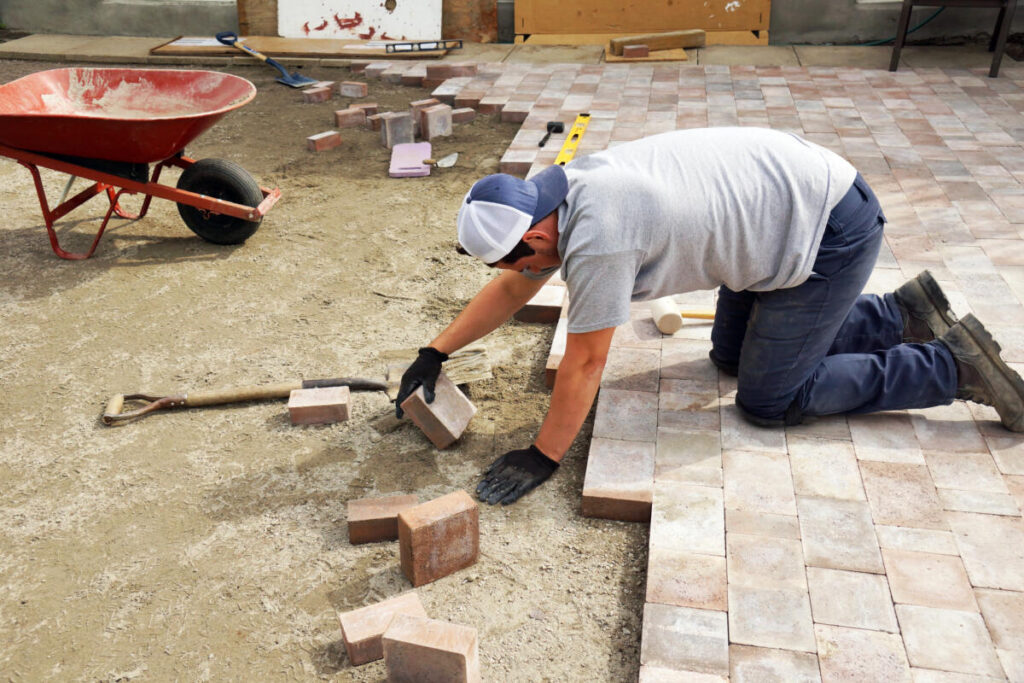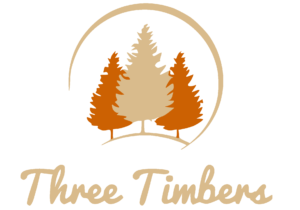Transforming your landscape doesn’t have to be a daunting task. With some creativity and elbow grease, you can create a stunning, personalized outdoor space that enhances your home’s curb appeal. This comprehensive guide will walk you through a variety of DIY landscaping projects, from creating curb appeal with visually appealing plants and hardscape elements to building beautiful water features and installing solar-powered landscape lighting. Get ready to roll up your sleeves and make your outdoor oasis a reality!
Key Takeaways
Transform your outdoor space into a beautiful oasis with DIY landscaping, featuring captivating plants and hardscape elements!
Create an inviting atmosphere with fire pits, seating areas and landscape lighting options.
Enhance the look of your property by upcycling discarded materials for edging solutions.
Creating Curb Appeal with DIY Landscaping
First impressions matter, and your home’s curb appeal can make a significant impact on how it’s perceived by others. With DIY landscaping, you can create a visually interesting and cohesive landscape design that draws the eye and increases the value of your property. Carefully choosing plants based on color, texture, and size can create a stunning front yard that stands out from the rest.
Incorporate focal points like trees and shrubs, as well as hardscape elements like patios, decks, and walkways, to tie the entire landscape together and create a polished look.
Choosing plants for visual appeal
When selecting plants for your landscape, consider their visual appeal and ability to provide interest throughout the year. Opt for evergreen shrubs and plants with lush, enduring foliage that will serve as a beautiful backdrop for your landscape all year round. Additionally, experiment with various plant textures and colors to create an interesting and unique outdoor space.
Combining different foliage textures and tree bark can create an interesting texture variety, while the strategic use of color can add dimension and visual weight to the plants.
Adding focal points with trees and shrubs
Establishing focal points in your landscape significantly contributes to depth and visual interest. Trees and shrubs can serve as natural focal points, providing structure and color to your outdoor space. Some excellent choices for creating beautiful focal points include:
Smaller trees that stay under 15 feet tall
Evergreen trees with glossy foliage
Trees with unique shapes and textures
Columnar trees that act as visual beacons in the landscape
These trees will add beauty and interest to your landscape, creating stunning focal points.
Strategically place trees and shrubs to create a captivating garden sanctuary that enhances the overall look of your property.
Incorporating hardscape elements
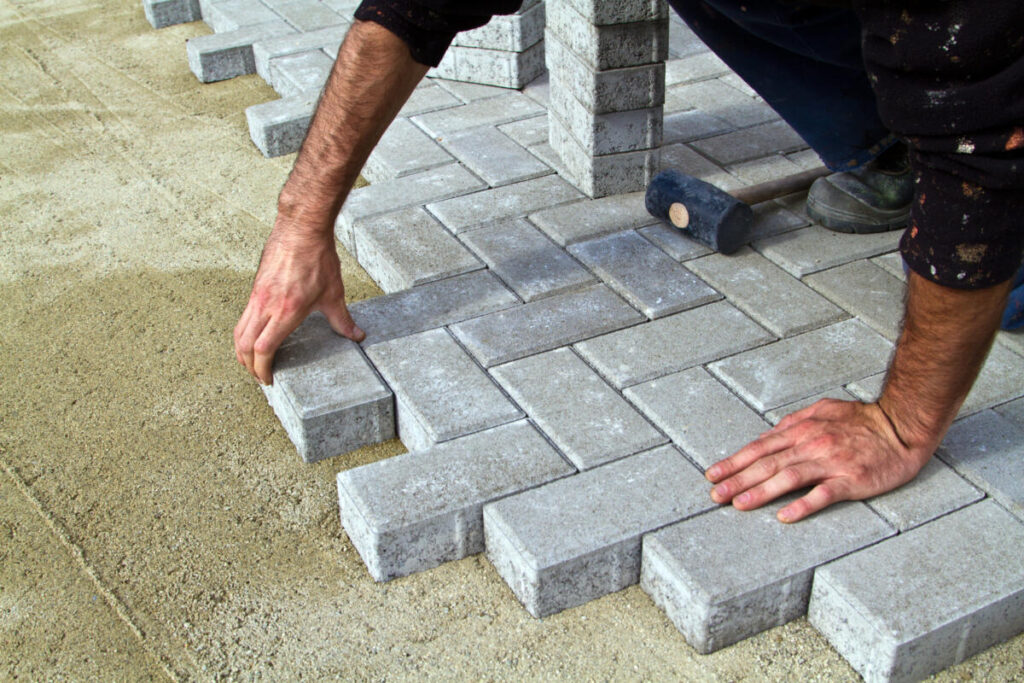
Elevate your outdoor space and inject sophistication by incorporating hardscape elements into your landscape design. Some examples of hardscape elements that can help to define spaces and add functionality to your landscape include:
Driveways
Stone patios
Walkways
Retaining walls
Terrace gardens
These elements can also be used to create a seamless transition between your home and garden, ensuring a cohesive and polished look.
So why not explore the possibilities of hardscape elements and see how they can enhance the beauty and functionality of your outdoor oasis?
Small Garden Bed Ideas
Small garden beds are a perfect solution for those who want a simple and manageable way to add vibrancy to their landscape. By incorporating drought-tolerant succulents, layered plants for texture, and colorful plants for depth, you can create visually appealing garden beds that fit any space.
Whether you have a small front yard or a sprawling backyard, these flower beds can be tailored to your unique landscape design and can make a big impact with minimal effort.
Drought-tolerant succulents
Drought-tolerant succulents are an excellent choice for low-maintenance, water-wise garden beds. They can go longer between waterings than other plants and are well suited to arid climates. Some examples of drought-tolerant succulents that can add a splash of color and resilience to your garden beds are:
Lantana
Coneflower
Pink Muhly Grass
Yarrow
Lavender
Selecting drought-tolerant succulents allows you to cultivate an eco-friendly garden that is visually appealing.
Layering plants for texture
Creating depth can be achieved by layering plants of different heights and textures in your small garden bed. By arranging taller plants in the back and shorter plants in the front, you can create a dynamic and visually appealing garden bed that draws the eye.
Additionally, combining different plant textures can add an extra layer of detail to your garden bed, making it an inviting and enjoyable space to spend time in.
Using color to create depth
Incorporating colorful plants in your small garden bed can create a vibrant and dynamic space. Utilizing different shades and hues of color can add depth to your garden bed, creating a stunning visual effect. By strategically placing lighter and brighter colors in the foreground and darker colors in the background, you can create an amazing sense of perspective and depth. Experimenting with color combinations can bring a lively and energizing atmosphere to your garden bed.
DIY Fire Pit Projects
A fire pit can be a fantastic addition to any outdoor space, providing warmth and ambiance on cool evenings. With a DIY fire pit project, you can create a cozy and inviting space for friends and family to gather around.
In this section, we’ll discuss:
The importance of choosing the right location for your fire pit
Selecting materials that are both durable and stylish
Considering safety precautions to ensure a successful and enjoyable fire pit experience.
Choosing the right location
The location of your fire pit is crucial for both safety and enjoyment. Here are some factors to consider when choosing a spot:
Choose a spot that’s sheltered from the wind
Ensure it is far enough away from any structures or combustible materials to minimize the risk of accidental fires
Consider the surrounding landscape features, such as trees and walls, which can help to create a barrier and block the wind, making the fire pit even more enjoyable to use.
Paying close attention to your fire pit’s placement ensures a safe and inviting space to be enjoyed by everyone.
Selecting materials for durability and style
Consider both durability and style when selecting materials for your DIY fire pit. Stainless steel, cast aluminum, and copper are all excellent choices for a fire pit that’s not only long-lasting and low-maintenance but also provides a modern or classic look.
By choosing materials that are heat-resistant and complement the overall aesthetic of your landscape, you can create a fire pit that’s both functional and visually appealing.
Safety considerations
Safety should always be a top priority when installing a fire pit in your outdoor space. To ensure a safe installation, follow these guidelines:
Follow all local building codes and safety regulations.
Keep the fire pit at least 10 feet away from any structures or combustible materials.
Use proper materials and techniques when constructing the fire pit, such as installing a fireproof base and surrounding area.
By following these guidelines, you can enjoy your fire pit safely.
Taking these safety precautions allows you to enjoy your fire pit with peace of mind, secure in the knowledge that you have done what’s necessary to protect yourself and your property.
Creating Outdoor Seating Areas
Creating comfortable and inviting outdoor seating areas is essential for making the most of your outdoor space. Whether you’re looking to entertain guests, relax with family, or simply enjoy some quiet time outdoors, having a dedicated seating area can greatly enhance your outdoor experience.
We will delve into the following topics:
Creation of DIY patio furniture from pallets
Use of stepping stones and walkways to connect seating areas
Shade solutions for enhancing the comfort and enjoyment of your outdoor seating areas.
Patio furniture from pallets
Building patio furniture from pallets is an affordable and customizable way to create seating for your outdoor space. Wooden pallets can be easily repurposed into a variety of furniture pieces, such as:
Sofas
Chairs
Tables
Benches
Loungers
With a little creativity and some basic tools, you can transform pallets into unique and functional pieces of furniture that are perfect for your outdoor seating area.
To construct your own patio furniture from pallets, you’ll need the following tools and materials:
Electric drill
Hammer
Prybar
Mallet
Circular saw
Reciprocating saw
Tape measure
Screwdriver
Sander
Safety goggles
Pallets
Screws
Nails
By following some simple DIY tutorials and using your imagination, you can create stunning and comfortable patio furniture that’s perfect for lounging, dining, and entertaining in your outdoor space.
Stepping stones and walkways
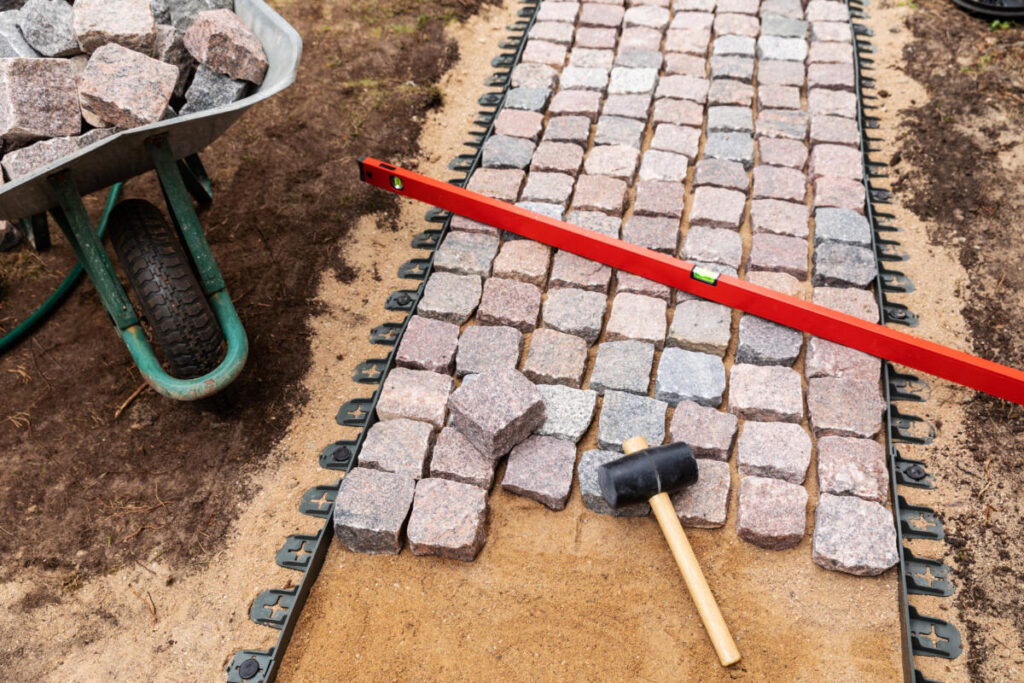
Stepping stones and walkways are a practical and visually appealing way to connect seating areas and provide a clear path through your landscape. They can be created using a variety of materials, such as concrete, natural stone, or even recycled materials like reclaimed wood or broken tiles.
To create a beautiful stepping stone walkway, you can start by following these steps:
Plan the design and width of the path.
Dig holes for each stepping stone.
Spread a layer of sharp sand in each hole.
Place the stones and make sure they are level.
Fill the gaps between the stones with fine aggregate or builders sand.
With these steps and a little effort and creativity, you can create a stunning walkway that adds both function and beauty to your outdoor seating areas.
Shade solutions
Adding shade solutions to your outdoor seating areas can greatly enhance their comfort and usability, especially during the hot summer months. Some options for providing shade include:
Pergolas
Umbrellas
Shade sails
Strategically placed trees or shrubs
Incorporating these shade solutions into your landscape design enables the creation of a comfortable and inviting space, perfect for relaxation, entertainment, or simply appreciating the beauty of your outdoor surroundings.
DIY Water Features for Your Landscape
Adding a water feature to your landscape can instantly transform your outdoor space into a tranquil and inviting refuge. From simple rock water fountains to elaborate ponds and waterfalls, there are numerous DIY water feature options to suit any taste and budget.
We will delve into the installation of a rock water fountain, the use of rope lights for nighttime illumination, and the selection of plants that prosper in water features.
Installing a rock water fountain
A rock water fountain can be a soothing and attractive focal point for any outdoor space. To install a DIY rock water fountain, you’ll need:
River rock or ornamental stone
A fountain basin with a lid
A fountain pump
Gravel for drainage
Various tools
When choosing the location for your fountain, consider factors such as visibility, access to a power source, and proximity to seating areas.
Rope lights for nighttime illumination
Rope lights are an easy and effective way to add nighttime illumination to your water feature, creating a magical and enchanting ambiance after the sun goes down. Simply install the rope lights around the base of the water feature or create a pathway of lights leading to it, ensuring they are securely in place and waterproofed if necessary.
Rope lights are not only visually appealing but also energy-efficient and long-lasting, making them an ideal choice for landscape lighting.
Choosing plants for water features
Choosing the right plants for your water feature is essential to ensure they thrive and enhance the overall appearance of your outdoor space. Some ideal choices for water features include:
Water lilies
Aquatic grasses
Lotus flowers
Water hyacinths
Water lettuce
These plants are well-suited to the damp environment and can provide a stunning visual display.
Select plants that complement the style of your water feature and landscape design, and be sure to provide the appropriate care and maintenance to ensure their continued health and beauty.
Upcycling Ideas for DIY Landscaping
Upcycling discarded materials and giving them a new purpose is a creative and sustainable way to enhance your landscape design. From turning an old house door into a charming garden gate to using reclaimed wood for a rustic fence, there are countless ways to repurpose materials and add a unique touch to your outdoor space.
We will examine some upcycling ideas for DIY landscaping, including the creation of planters from discarded materials, and discuss their incorporation into your personal landscape design. In this article, we will explore various diy landscaping ideas that can help you transform your outdoor space into a beautiful and functional diy landscaping project.
Turning an old house door into a garden gate
An old house door can be repurposed as a unique and charming garden gate, adding character and a touch of whimsy to your landscape. To transform an old door into a garden gate, simply remove any hardware, sand and paint the door, attach hinges and a latch, and install the gate in your desired location.
Using reclaimed wood for a rustic fence
Using reclaimed wood for a rustic fence is a great way to add character and charm to your landscape while also being eco-friendly. Reclaimed wood can be found at salvage yards, construction sites, or even in your own backyard, and can be used to create a variety of fencing styles, from traditional picket fences to more modern designs.
To construct a fence with reclaimed wood, simply clean and treat the wood, design your fence layout, and assemble the fence using nails, screws, or other fasteners.
Creating planters from discarded materials
Creating planters from discarded materials is a creative and eco-friendly way to add a touch of personality to your landscape. Here’s how you can do it:
Choose your material – old tires, pallets, pieces of furniture, etc.
Clean and prepare the material.
Add drainage holes if necessary.
Fill the container with soil.
Plant your desired plants.
With a little imagination and some upcycling know-how, you can create one-of-a-kind planters that not only serve a practical purpose but also add a distinctive touch.
Easy DIY Landscape Edging Ideas
Landscape edging is an essential element of any well-designed outdoor space, as it helps to define garden beds, separate lawn areas, and create a clean and polished look. There are numerous easy DIY landscape edging ideas to choose from, including mulch and rock borders, paver edging, and metal or plastic edging.
We will examine these diverse edging options and discuss their integration into your personal landscape design for a cohesive and visually appealing outdoor space.
Mulch and rock borders
Creating a simple and natural border with mulch or rocks is an easy and affordable way to separate garden beds from lawn areas. To create a mulch or rock border, simply dig a shallow trench along the edge of your garden bed, place the mulch or rocks in the trench, and pack the material firmly in place.
Mulch and rock borders not only provide a clean and polished look but also help to control weeds and improve soil health.
Paver edging
Installing paver edging is another easy DIY landscape edging idea that can help to define your garden beds and create a clean, polished look. Paver edging is typically made from concrete, brick, or stone, and can be installed in a variety of styles and patterns to suit your landscape design.
To install paver edging, simply dig a shallow trench along the edge of your garden bed, place the pavers in the trench, and secure them in place using landscape stakes or adhesive. Paver edging is not only durable and low-maintenance but also adds a touch of elegance to your outdoor space.
Metal or plastic edging
For a durable and low-maintenance landscape edging option, consider using metal or plastic edging. These materials are available in a variety of styles and colors to complement your landscape design and can be easily installed using landscape stakes or adhesive.
Metal or plastic edging is an excellent choice for defining garden beds, separating lawn areas, and creating a clean and polished look in your outdoor space.
DIY Landscape Lighting Options
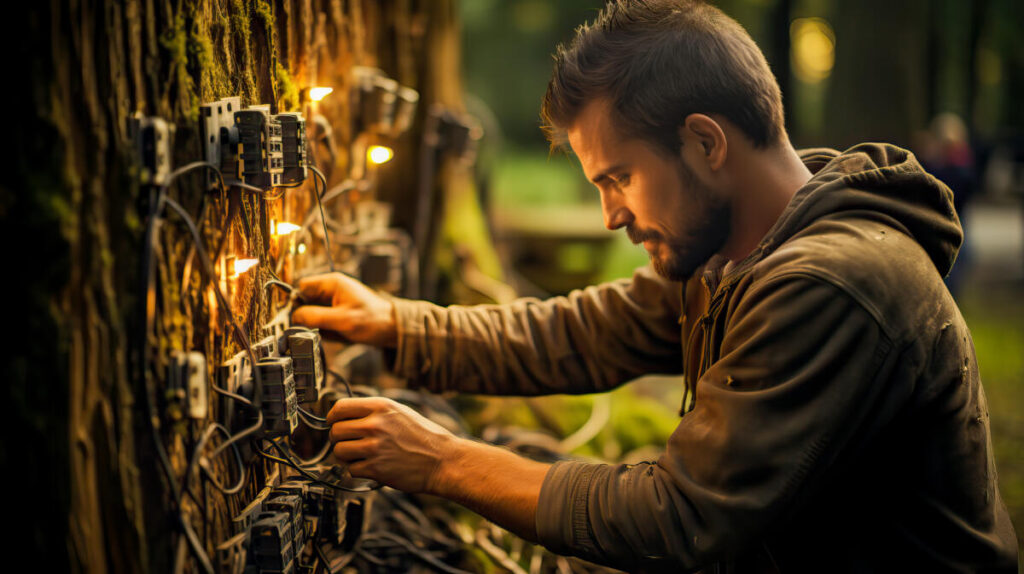
Landscape lighting is an important aspect of any outdoor space, as it not only enhances the beauty of your landscape but also improves safety and security. There are several DIY landscape lighting options to choose from, such as string light posts and solar-powered cedar cube lights.
We will discuss these lighting options and their incorporation into your landscape design for a warm and inviting ambiance during nighttime.
String light posts
Installing string light posts is a simple and effective way to add a warm and inviting ambiance to your outdoor spaces at night. String lights can be hung from posts, trees, or other structures to create a cozy and enchanting atmosphere that’s perfect for entertaining, relaxing, or simply enjoying the beauty of your landscape after dark.
To install string light posts, you’ll need to follow these steps:
Determine the placement of the posts.
Dig holes for each post.
Secure the posts in the holes using concrete or other materials.
Hang the string lights on the posts, making sure they are evenly spaced and securely attached.
Solar-powered cedar cube lights
Solar-powered cedar cube lights are:
An eco-friendly and stylish way to illuminate your landscape at night
Made from cedar wood
Powered by solar energy
A sustainable and energy-efficient lighting option.
To make your own solar-powered cedar cube lights, simply gather inexpensive solar landscape lights, create cedar cube enclosures for the lights, and place the solar panels on top of the cubes. Once installed, these unique lights can add a touch of warmth and magic to your outdoor space, all while being kind to the environment.
Summary
In conclusion, there are countless ways to transform your landscape with creative and cost-effective DIY landscaping projects. From enhancing curb appeal with visually appealing plants and hardscape elements to installing unique water features and eco-friendly landscape lighting, the possibilities are endless. So why not embrace your inner DIY enthusiast and start planning your next landscaping project today?
Frequently Asked Questions
Is it hard to do landscaping yourself?
DIY gardening can be a great option for simpler landscapes, but formal arrangements may require professional help.
Is there a free app to design your backyard?
Discover the perfect outdoor décor and plan a beautiful backyard with DecorMatters free design app. Join 10+ million users today to make your outdoor dreams come true.
How do I landscape my backyard on a budget?
Create a beautiful backyard on a budget by using budget-friendly DIY ideas like installing mixed planting beds, groundcover, easy-growing perennials, affordable hardscaping and DIY water features. Other cost-saving ideas include freshening up mulch beds, planting perennials, improving edging, growing native plants and incorporating xeriscaping elements. Finally, take advantage of cheap landscaping ideas such as adding a walkway, saving with perennials, spreading some mulch, planting flowers, raising your garden bed and repurposing items as planters.
What are the 7 steps to landscape design?
Create your new landscape with these seven easy steps: Plan a project, remove the lawn, install hardscape, build a healthy soil, install an irrigation system, purchase and install plants, and water efficiently.
What are some low-maintenance plants for small garden beds?
If you’re looking for low-maintenance plants that won’t require much water, consider Lantana, Coneflower, Pink Muhly Grass, Yarrow, and Lavender – all perfect for small garden beds.

